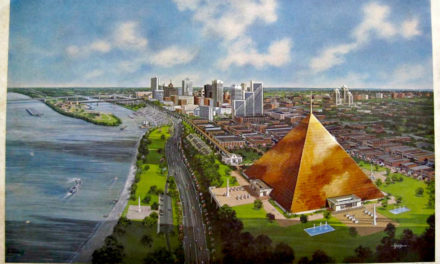
It may be that after more than a decade of hyperbole, downtown Memphis may be poised to deserve it.
There are a number of initiatives and projects under way that will fundamentally reshape downtown. While they are largely bi-coastal – on the south and north ends of downtown – they are significant and major investments in its future. With luck, in time, the energy they create will turn into momentum that can improve what’s in between.
Paul Morris has done a great deal to breathe life into downtown, and as the Morris era turns into the Patterson era with Terence Patterson at the helm, maybe terms like renaissance will finally make sense in the downtown boosterism.
Downtown Has What’s Important
This new era begins not only with some exciting projects, but among the 100 largest cities, downtown Memphis was #38 in population growth from 2000-2010 at 22%. Unlike many downtowns, however, our population growth skews older, and as a result, we’ve not really benefitted from the national migration of young talented people to downtowns.
As our friend Joe Cortright at City Observatory has shown in his groundbreaking research, 25-34 year-olds shows a profound preference for living within three miles of the CBD – 51%. It was 10% in 1980, 12% in 1990, and 32% in 2000. Unquestionably, downtown Memphis has what this demographic is seeking – density, diversity, interesting options, bikeable, walkable, and transit-served – but we remain to see the influx recorded in other places.
In that way, downtown has an interesting balancing act. Downtown needs more young people and the population growth from it to attract jobs (just like the jobs that followed talent in jobs sprawl, fast-growing firms follow knowledge workers downtown). While downtown needs to recruit young entrepreneurs and startups, it also has the opportunity to figure out a way to make better use of all the Boomer talent living downtown and to determine some innovative ways that it can drive growth and progress.
It’s Worth The Fight
Back to the major projects, it’s good to see that the boards of the Downtown Commission have turned their attention – and incentives – to transformative projects. It’s a smart strategic decision, and with apartment occupancy approaching 95%, it seems like there’s enough market demand that incentives aren’t still needed for these projects while the Commission focuses on the toughest challenge of all – attracting offices and companies back downtown.
The strategic priorities for downtown established in the early years of the old Center City Commission in the mid-1970s was for it to be the regional center for finance, culture, government, and commerce. Both Shelby County and City of Memphis agreed to the priorities and for a time, they fought any threat to these foundational priorities. But, after awhile, everyone took their eyes off the ball, and even government was moving agencies and departments eastward.
As we have said before, sadly, for many years, no one was willing to fight for downtown as major law offices, major banks, and large companies moved eastward. That changed under Mr. Morris’ leadership and hopefully, the Downtown Memphis Commission will double down on it during the Patterson years.
It’s The Smart Location
The national average for MSA jobs within three miles of the CBD is 23%. Here, downtown has 12.4%, the lowest by far of the four major cities in Tennessee.
Across the U.S., the Central Business District is again attracting major companies or expanding existing ones. (It’s a good time to say a deep thank you to AutoZone.) There’s Bridgestone in Nashville, Omnicare in Cincinnati, Cirrus Logic in Austin, Zappos in Las Vegas, and MindMixer in Kansas City. While we are not part of the full-throated cheerleaders for tax freezes, there is no package of incentives that aren’t justified if we could get a major corporate headquarters downtown.
In its Smart Location Database, the U.S. Environmental Protection Agency set out the five factors accelerating vibrant communities – density, diversity, design, distance to transit, and destination accessibility. As our friend Jeff Speck wrote in his book, Walkable City: How Downtown Can Save America, One Step at a Time, anything that improves walkability improves vibrancy. Those would make useful cornerstones for the work of the Downtown Memphis Commission.
Upgraded Public Spaces
Dynamic downtowns also have high-functioning public spaces and attention to detail and design. We don’t have enough of these, and this should be a priority for Downtown Memphis Commission. Downtown’s parks are underused and cry out for innovation solutions and programming to create reasons for people to come downtown, and in addition, improvements should be more intense and have a point of view.
Often, our intentions are good with projects like RiverFit in Tom Lee Park or plans for the bluffs behind the University of Memphis Law school, but we spread out equipment or outdoor furniture over too large of an area so they lack impact. Every downtown park should have a reason to exist rather than being passive places that don’t invite us in for a peak experience.
We need Downtown Memphis Commission to drive this long overdue discussion about the use, personality, and purpose of each park and other public spaces, and it should not abdicate this role to any other agency.
Meanwhile, arts and culture – as proven on South Main – can be powerful vehicles for enlivening downtown and create a sense of place. It’s why the new leadership at Downtown Memphis Commission should do whatever it can to move Memphis Art Park ahead, because it offers a unique opportunity to transform the moribund Cossitt Library into a hub of vibrancy.
Design Matters
As for design, downtown has already been subjected to too much suburban design, and it should reject these prototypes at all cost. They result in reduced density, too much surface parking, and simply bad design that feels out of place. We should be way past the time that we feel that downtown has to accept anything it is offered. Emphasis on good design would prove it.
There is now too little sense of an urban palette but rather a hodgepodge of ideas from an assortment of city agencies doing their own thing. There are the trolley signs that are eyesores, there are barriers of newspaper stands, there are various signs that have no rhyme or reason in their graphic design, there are poles in the middle of sidewalks, there are benches in riverfront parks facing away from the river, there is landscaping dwarfed in oversized containers, there are ugly garbage receptacles, utility boxes scattered all over downtown blocking sidewalks and serving as an ugly reminders of MLGW’s disregard for aesthetics, and just a general lack of the kind of design that could heighten downtown’s special sense of place.
Mr. Morris gets kudos for finally getting Main Street into good shape again after more than a decade of neglect by city government. As a result, its embarrassing lack of maintenance and broken pavers and grates are things of the past.
It was a big step forward, and we hope the new leadership keeps it going with more attention to streetscapes, because they send a clear message about what we think about our downtown. Over the years, trees have been cut off at sidewalk level and never replaced and as a general rule, we need to five more emphasis on incentives for streetscape improvements.
It’s Up To Us
Speaking of better design and better public spaces, Downtown Memphis Commission should develop a plan to remove the ugly garages that are remnants from the days when the riverfront was considered irrelevant. We know that change won’t come quickly, but we need a different vision for the future for these irreplaceable places with magnificent vistas of our riverfront.
Finally, downtown Memphis should be a showplace for public art. We have the long-held dream of George Segal-like sculptures of the heroes of Memphis history and the giants of Memphis music. They would become must-have photographs for tourists and residents – sitting on a bench overlooking the river with Furry Lewis, B. B. King, or Justin Timberlake. We need to make public art ubiquitous downtown so it can create surprising treats in the downtown experience.
No neighborhood in Memphis has more passionate advocates than downtown, and there is the rich opportunity to engage them more directly into plans for the future, but also, in acting as advocates to Memphis and Shelby County Governments for more funding and as a sources of ideas for improving the experience, the environment, and trouble shooters to ensure that downtown is as special as it deserves to be.
Hopefully, years from now, we will look back on the Morris years as the beginning of a new era for downtown and that it was propelled forward by the ambitious, aggressive leadership of the Patterson era. We could well be on the brink of a time of exciting progress, but it takes all of us to make it happen.
***
Join us at the Smart City Memphis Facebook page for daily articles, reports, and commentaries that are relevant to Memphis.





Meh.
I want to be excited about these possibilities, but at the end of the day, so much of the city’s focus and resources seem to go toward “prettyifying” downtown, while the majority of the rest of Memphis looks like old Beirut.
It would be REALLY fantastic if there was an EDGE-like commission focused on “prettyifying” urban blight wastelands like 38106 and 38116, 38107–in such a way where the poor families who live and suffer there NOW and continue to afford to live there after the neighborhoods are “prettyified.” A kind of gentrification without the subsequent exodus of the low-income because they can no longer afford their housing.
Just saying. Most Memphians spend not a whit of time in Downtown, unless they are in the long refugee lines at the court house dealing with some broken tail light foolishness. It would be nice to be able drive around the city and see beauty throughout, rather than the same two or three spots Memphians have to duck and hide to get to, just so they aren’t shamed in front of their out of town guests, Wake me when all of Memphis becomes a priority, and not just the strips of land the bedroom suburbanites care about.
We don’t disagree, although if the state of downtown is the result of so much of the city’s focus, we’re in real trouble. It has been underperforming, but just might be turning the corner finally. Its success is important to all of the zip codes you mention because downtown continues to be a significant source of tax dollars paying for things in those neighborhoods and hopefully, its tax base will grow even more because as you say, we need to be spending money on those zip codes and many more.
Greater Memphis Greenline and Paint Memphis strongly agree with the notion of “prettifying”. In fact with the city’s permission the Wolf River flood wall now features the work of 70+ artists on the section of the wall the runs between Evergreen and Watkins along Chelsea Avenue in north mid-town (38107).
Quite intentionally the art does not face Chelsea Ave. The art faces south (where the residents are). It’s the longest art gallery in Memphis (over a 1/4 mile long). The theme suggests neighborhood revival. The objective is to beautify the area for the benefit of area residents and to give people a reason to go to this often-neglected area of north Memphis.
It’ also a precursor to development of the Chelsea Avenue Greenline , which is now in design phase.
I’d say the golden era of downtown Memphis was 50 years ago! Downtown, along with much of the city has been in a dismal decline for decades. First, downtown has very few jobs to offer and it is office workers who are the lifeblood of any city’s downtown. We have far too many empty, blighted buildings (Sterick, 100 N Main, etc) and way too many empty parcels and parking lots. Beale St is both tacky and dangerous and the venues there are not genuine or compelling. Compared to many other downtowns in other cities, Memphis is truly dismal. Just look at how much is being built all over Nashville and we see that Memphis is light years behind. We can try to “prettify” as much as we want, but downtown Memphis pretty much sucks.
Jaco’s comments I believe are an ongoing case study in viewing downtown through the lenses of the past. I’m in the process of building a townhome there now; I can guarantee you the area doesn’t “suck.” It is true there are many empty parcels and surface parking lots, however that simply represents infill opportunity on a grand scale. If I’m not mistaken, about 63,000 employees work in the environs; encouraging a modest proportion of those people to both live and work downtown could only increase vitality in the area.
Thanks for your response, Smart Memphis! And Syd Lerner, that sure sounds pretty! I will have to roll through there to see the murals, since that area could use some love.
The zip codes I mentioned not only need tax dollars to repair basic infrastructure like raggedy potholed streets, but they need a new, smarter policy with TEETH from the city that will allow Memphis to go after absentee slumlords who are the basis of the eye sores and urban blight. I don’t why or how some of that housing–that looks like it came right out of the slavery plantation and sharecropping eras–is even allowed to remain standing, let alone rent to people to actually live in. It’s 2015 and many of those houses look like some mess right out of Sugar Ditch. A crying and a shame indeed. I say give them out-of-town “investors” or the local slumlord sneaky pete’s thirty days or a few months to get their acts together, or snatch the properties up, bulldoze them if needed, and build something that looks like it is remotely connected to the 21st century. I would post pictures, but I suspect some of your readers already know what I mean. A disgrace. That’s the kind of “prettyifying”–not just murals and bike sculptures in neighborhoods where the only people riding bikes are homeless people who aren’t too happy about it. Can we put the other Memphis on par with the rest of civilization? That’s my Memphis dream.
It gets my dander up when we talk of Downtown art from the perspective of “looking South”. The problem is we have always concentrated on Main Street and a bit of Front and Second Street. I believe there is a direction termed “East”. I would like to see a true effort made by the Downtown Commission to spur renovation of the Sterrick Building and other abandoned buildings along Second and Third Streets. Developing functional eastward corridors (more than just bike lanes) with housing and employment centers out to the Edge Community and the Medical Center is badly needed. I could go on, but ou get the gist. We can prettify only to a point and then we have to produce a realistic community with all amenities and opportunities.